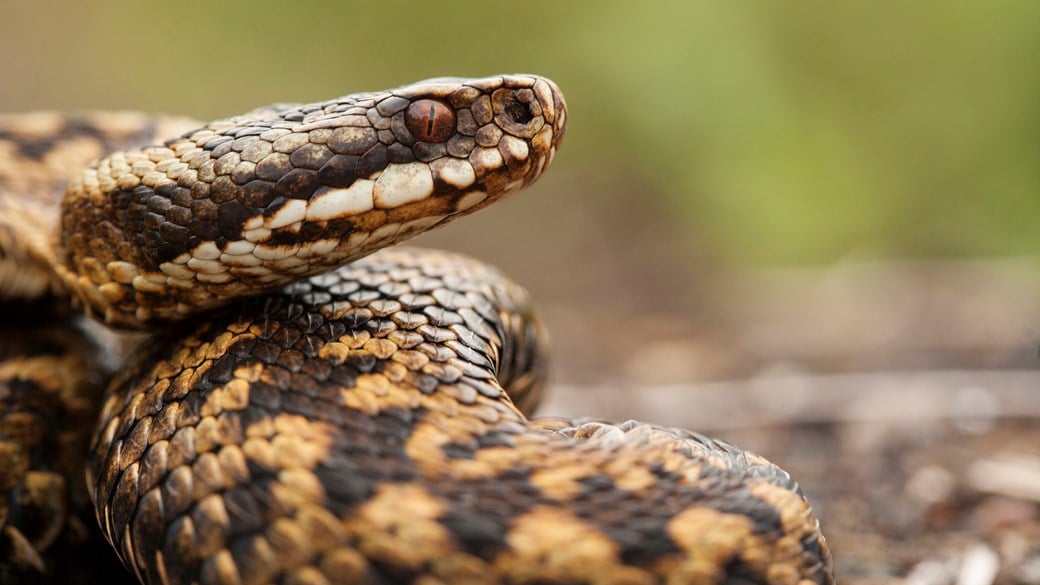
Adder Bites
The European adder is the only venomous snake native to the UK.
The only venomous snake native to the UK is the European adder (Vipera berus). Adults are roughly 50-60cm long and have a black/brown zigzag pattern along their back and V or X shaped marking on the back of the head. They are most commonly found in the south and south west of England, western Wales and Scotland where their preferred habitats are sand dunes, rocky hillsides, moorland and woodland edges.
Adders are protected by the Wildlife and Countryside Act 1981; this means that it is an offence to kill, harm, injure, sell or trade them.
More about adder bites
Adder bites are fairly rare. Snakes generally only bite in self-defence, so normally bites occur when a snake is stepped on or disturbed by your dog. Puppies and young dogs can be especially curious and can unintentionally provoke an adder into biting.
The majority of bites in dogs seem to occur between April and July, most commonly in the afternoon when the adders are most active.
Adder bites can result in swelling around the wound, usually within 2 hours, and this can be severe. You might be able to see the 2 puncture wounds in the centre of the swelling.
Other than swelling your dog may show signs of pain, bleeding, bruising, lameness and may appear nervous.
If the adder venom is absorbed into the rest of the body it can cause a widespread inflammatory reaction leading to symptoms such as lethargy, fever, increased heart and respiratory rates, drooling, vomiting and a wobbly gait.
In severe cases animals may collapse, have blood clotting problems, organ failure, tremors or convulsions.
Bites most commonly occur on a dog’s legs or face. If your dog is bitten on the face, it could lead to swelling of the face and muzzle and may result in breathing difficulties.
The severity of the clinical signs and the speed of recovery can vary and depends on:
- the speed of veterinary treatment
- the location of the bite
- the size of the patient (small patients can be more severely affected)
- the amount and potency of the venom
- the amount the patient moves after it's been bitten
- any pre-existing disease within the patient (this may make them more likely to develop severe clinical signs)
First of all, seek veterinary attention. It’s important to remember not to panic; your dog is highly likely to fully recover if treatment is given promptly. Carry your dog (rather than allow him or her to walk) to try and reduce the spread of venom around the body. Bathe the wound in cold water to help control the swelling and try to keep your dog quiet and warm as you travel to your nearest vet practice.
As with any emergency, it is a good idea to ring your vet in advance to let them know what has happened and your estimated time of arrival. This means the practice can make sure they have a vet available to see you and it gives them time to prepare any treatments. If you’re unaware your dog has been bitten but you notice anything which may be suggestive of a bite later on, it’s important that you ring your vet without delay, even if it is outside of normal opening hours.
Even though signs can be severe, 96-97% of cases survive with the appropriate treatment. Treatment depends on the individual case and recovery times can vary from 24 hours to 30 days. The average time to a full recovery is 5 days. Because the bite and swelling is painful, pain relief will usually be given. Your vet may recommend fluid therapy (a drip) to maintain blood pressure, treat shock and maintain the blood flow of the vital organs. Anti-histamines might be added to the treatment. Sometimes cage rest is recommended to minimize venom absorption into the rest of your dog's body. In some cases, if it is available, anti-venom is used. It makes the venom inactive by binding to it and therefore ensures no further damage is caused.
Anti-venom can be used in all cases but is especially recommended for potentially serious cases. Unfortunately, it can be difficult to obtain. It needs to be imported because there is currently no preparation licensed in the UK.
